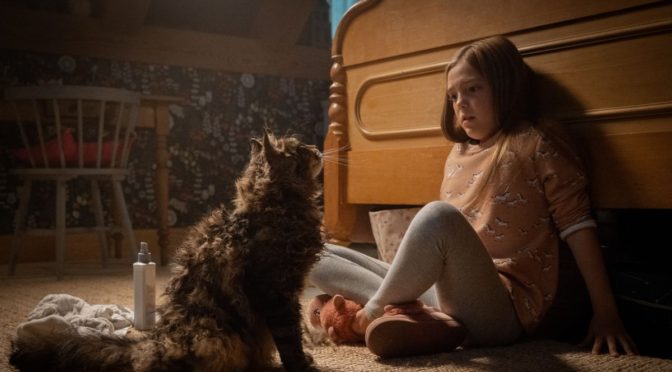Seeking a new start, the Creed family move to a secluded house in Maine, where father Louis (Jason Clarke, FIRST MAN) hopes to spend more time with his wife Rachel (Amy Seimetz, ALIEN: COVENANT) and their two young children. But soon enough, cracks appear in their new idyll – not least the huge trucks that shatter the peace every time they thunder past the house – and the unsettling landmark in the ancient woods nearby, where generations of children have buried their pets1.
After the runaway success of Warner Bros’ IT (2017) (one of the highest grossing horror films of all time), it’s unsurprising that Paramount were keen to cash in on their most well-known Stephen King property, his 1983 novel PET SEMATARY. Unlike IT, the storyline of SEMATARY feels primal – as if the core of it always existed, and King interpreted it from some universal dream. (Then again, this sensation may be down to the fact that it was parodied in THE SIMPSONS.) There’s a terrible sense of inevitability to the proceedings; reading it, we feel we know exactly what will follow, events falling into place one after the other like a set of dreadful dominoes. The strength of the book is couched not in scary set-pieces, but in a gut-wrenching and ever-present sense of dread. This is so often the heart of satisfying horror, both on the page and on screen: creating fear and suspense by implying much, but showing as little as possible. Every audience knows the disappointment of seeing the monster too soon (there are notable exceptions: see THE THING).
So it’s hard to know who missed the memo with this adaptation of King’s masterful novel. This isn’t to say that it’s a bad, boring or even unenjoyable outing. SEMATARY is a solid film with a smattering of entertaining moments. Stylish flourishes (the flicker of a red traffic light echoed by the dripping of blood from a gurney) hint that the directors (Kevin Kölsch and Dennis Widmyer, STARRY EYES) have some gruesome artistic flare. Vivid flashback scenes and judicious shots of gore add spice to the narrative, while the ending (without saying too much) puts an interesting twist on the original. The lashings of dry ice that carpet the forest beyond the Sematary are just schlocky enough to be allowed – and Jason Clarke’s haunted eyes were surely crafted by the gods for the sole purpose of portraying insane grief. And it is, at times, a spooky watch, with especial credit to the cat.
There are, however, two major issues that diminish the power of SEMATARY’s indestructible premise. Firstly, the beginning is rushed, with the elements of overt horror entering the narrative far too early. Since there is no initial period of calm status quo, the audience has no time either to experience growing dread (‘surely something bad is going to happen soon’) or to get to know our central family. As such, we are less concerned about their welfare during the events that follow – a severe flaw in a genre that relies on empathy.
Secondly, while there are hints of imagination, the handling of horror in the film is, for the most part, rather safe. Early scenes in particular suffer from a lack of subtlety. Dialogue tends to the portentous and obvious, especially in scenes with walking omen Victor Pascow (Obssa Ahmed). Anything remotely unsettling is flagged with designated spooky music (actually, the scariest sequence benefits from no music whatsoever). This, reinforced by the addition of ritualistic animal masks to the mix, suggests either distrust in the audience’s capacity to know when they should be scared or – more worryingly – a lack of faith in the power of the finished product. This isn’t entirely misplaced, as many of the third-act scares fall down due to a very specific piece of miscasting.
The idea behind King’s original 1983 novel is indestructible. Coasting on the power of that premise, PET SEMATARY (2019) succeeds in being enjoyable and passingly creepy. However, a rushed first act, a heavy-handed approach and the failure of key horror elements mean that the final product rarely strays beyond the pedestrian – and never achieves the depth or staying power of other beloved King adaptations.
1 In an ideal world, this is as much as the casual viewer would know before entering the screen to view PET SEMATARY. Unfortunately, most of the major plot events are shown in the trailer, which is worth avoiding for this reason.

